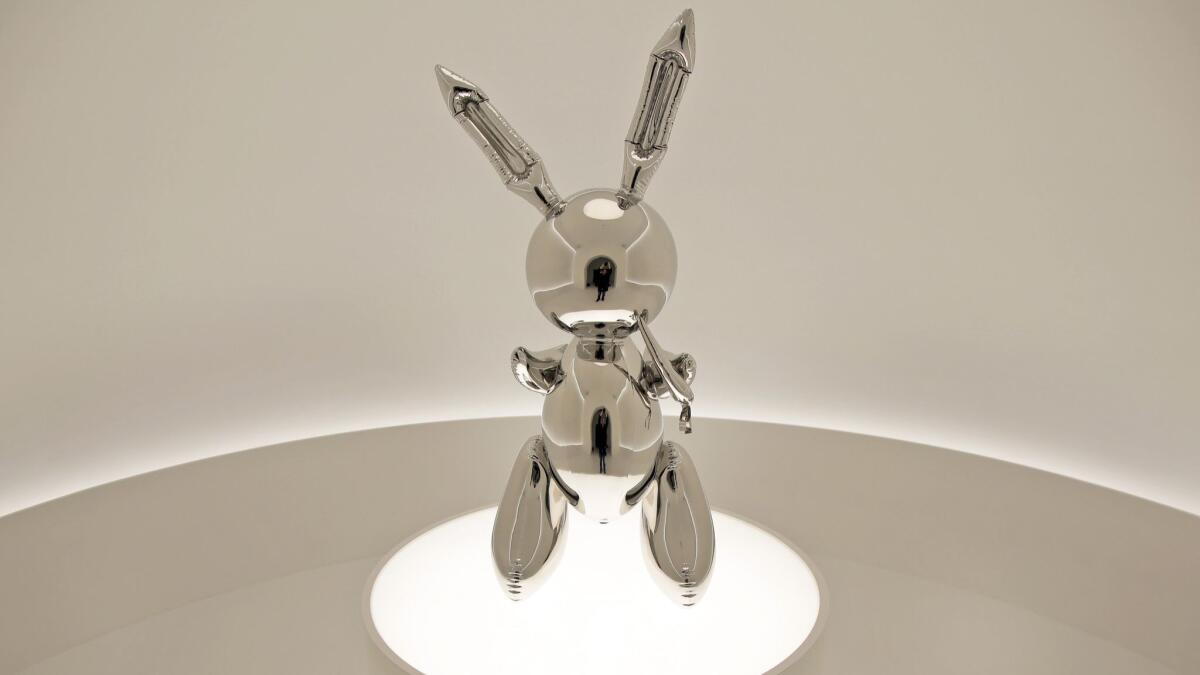Column: The $91-million sale of a cheesy Jeff Koons statue shows the need for a wealth tax

A few years ago, the joke going around was that a cocaine habit was God’s way of saying you have too much money. Cocaine is out of favor today, but for the 0.01%, high-priced art has taken its place.
Witness the latest moment of excess in the art market, the $91.1-million sale at Christie’s of a stainless steel sculpture of a rabbit by the glamorous artist Jeff Koons.
The sale on May 15 set an auction record for a work by a living artist, outstripping the previous record of $90.3 million, set in November for a work by David Hockney. (That sale broke a record of $58.4 million set in 2013, also for a work by Koons.)
The number of billionaires worldwide has more than quadrupled since 2000, and many devote part of their wealth to ... a passion for art.
— Mark H. Haefele, UBS
The buyer of record in the latest sale was Robert E. Mnuchin, a former executive at Goldman Sachs who currently plies his trade as an art dealer. He’s the father of Treasury Secretary Steven T. Mnuchin, which must stand as some sort of commentary on 21st century robber barons and their relationship with a plutocrat-loving administration in Washington.
It’s proper to note that higher prices have been paid for works of deceased artists — a couple of dozen sales in that category have been recorded, topped by the $450-million sale of “Salvator Mundi,” a portrait attributed to Leonardo da Vinci, to the Abu Dhabi Department of Tourism in 2017. The buyers in this market include hedge fund managers such as Steven A. Cohen and Ken Griffin and the Russian oligarch Dmitri Rybolovlev (the previous owner of “Salvator Mundi”).
What the surge in auctions of high-priced artworks really brings home is the weakness of arguments against higher marginal income tax rates on the wealthy and against the wealth tax proposed by Sen. Elizabeth Warren (D-Mass.), a candidate for president.
Warren’s proposal calls for a tax of 2% on net worth above $50 million and another 1% on net worth above $1 billion. Her economic advisors, Emmanuel Saez and Gabriel Zucman of UC Berkeley, have said that would affect about 75,000 U.S. households, or less than 0.1% of the total, and raise $2.75 trillion over 10 years — about 1% of gross domestic product per year. Her plan goes hand in hand with other proposals to raise the marginal rate on the richest Americans to as much as 70% from the current 37%.
As Saez and Zucman have observed, the top 0.1% today control almost as much wealth as the bottom 90%. Wealth disparity on this scale has a distinctly corrosive effect on society and democracy. As political economist Benjamin Friedman wrote in 2009, its “grave moral consequences” include “racial and religious discrimination, antipathy toward immigrants, [and] lack of generosity toward the poor” — all features of our current political landscape.
The goal of raising taxes on the rich is to mediate the economic consequences of placing so much wealth in the hands of people who can’t use it productively, while the majority of Americans struggle to make ends meet on working-class wages.
The mantras one hears from the water carriers for the wealthy is that they’re the “job creators,” the engines of economic growth, and that it’s folly to discourage them from working by imposing a stiff tax on their last dollars of earnings and wealth.
That brings us to the question of what’s produced by the auction sale of a piece of modern art.
First, a few words about Jeff Koons, the artist. He’s not unanimously respected by art critics, to put it mildly, even by those who favor Dada and avant-gardism, the general categories that encompass his work. Critic Jed Perl referred to a 2014 Koons retrospective at New York’s Whitney Museum of American Art as “a multimillion-dollar mausoleum in which everything that was ever lively and challenging about avant-gardism and Dada and Duchamp has gone to die.”
Perl called the showpieces “swaggeringly obnoxious … a succession of pop culture trophies so emotionally dead that museumgoers appear a little dazed as they dutifully take out their iPhones and produce their selfies.”
You get the picture. The record-setting works in 2013 and earlier this month were both from a Koons series of shiny statues based on balloon animals, which supposedly represent “a sly critique of middle-class values.” (The line comes from Perl, who isn’t having any of it.)
What Koons really is marketing is a brand name. The vigorous market for his work gives the lie to assertions about what wealthy buyers are looking for in their art purchases. Mark H. Haefele, a UBS executive who wrote the foreword for this year’s Art Basel/UBS report on the global art market, observed that “the number of billionaires worldwide has more than quadrupled since 2000, and many devote part of their wealth to building up collections, driven by a passion for art.”
Well, “a passion for art” can be defined in multiple ways, not all of them consonant with good taste. J. Pierpont Morgan, who established the style of international art collecting during the original Gilded Age, at least had the wisdom to put discerning art experts on his payroll. That’s not to say he didn’t buy a lot of junk, however, overpaying all the way.
The Art Basel report states that the best-performing art market in the world in recent years is the U.S., possibly because its 0.01% have been able to retain their wealth better than those in other countries despite the recession — and have been succored by policies such as the 2017 tax cuts. The U.S. has led a global art market valued at $67.4 billion in 2018, its highest level since 2014.
It may be said that the purchase of vanity assets by the upper crust does create jobs and trickles their wealth down. Yacht and mansion builders, after all, also have to eat. But those sectors are mostly economic froth, and highly volatile. They’re not mass employers, but symptoms of a concentration of wealth in America that make the gilt of the 19th century Gilded Age look like poverty.
Keep up to date with Michael Hiltzik. Follow @hiltzikm on Twitter, see his Facebook page, or email michael.hiltzik@latimes.com.
Return to Michael Hiltzik’s blog.







